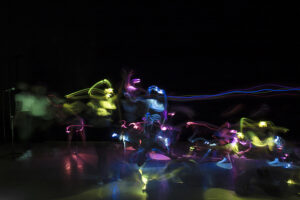The Rose of Sharon, Bloomed
Choreography
Live Performance, Participants with 5 Color Headlamps in Public
by Jihyun Kim
20 Pigment Prints, 20 x 30 inches
Installation, Video Projection onto Pigment Print with sound, Dimension Variable
Installation, Computer, Live CCTV, Video Projection onto Print and Sound, Dimension Variable
by Taejoong Kim





















The Rose of Sharon, Bloomed #1-1, #1-2, #1-3, #1-4
The Rose of Sharon, Bloomed #2-1, #2-2, #2-3, #2-4
The Rose of Sharon, Bloomed #3-1, #3-2, #3-3, #3-4
The Rose of Sharon, Bloomed #4-1, #4-2, #4-3, #4-4
The Rose of Sharon, Bloomed #5-1, #5-2, #5-3, #5-4

Korea: ‘무궁화 꽃이 피었습니다’ (The rose of sharon bloomed)
Japan: ‘だるまさんがころんだ’ (The Daruma Fell Over)
Czech: ‘Cukr, káva, limonáda, čaj, rum, bum’ (Sugar, Coffee, Lemonade, Tea, Rum, Bang)
Poland: ‘Raz, dwa, trzy, Baba Jaga patrzy’ (One, two, three, Baba Yaga is looking)
The Rose of Sharon, Bloomed, co-created with the New York-based choreographer, Jihyun Kim is an interactive performance that captures the movement and light during a popular children’s game called “Red Light, Green Light,” which is played in many countries under various names. The title of the artwork is derived from the Korean variation of the same name, and it depicts 20 rounds of the game through long-exposure photographs and videos. The choreographer built the choreography that symbolizes the appearance of a rose of sharon with five petals. Five dancers, with diverse ethnicities, were directed to approach the tagger with their own choreography. The dancers wear headlamps with five distinct colors, dividing the color space into five equal sections. The game features four distinct winners when there are five taggers. 5 × 4 = 20; the 20 photographs represent the series of The Rose of Sharon, Bloomed.
The installation is combined with a CCTV camera, live streaming projection and two types of photography; 20 color photographs on one wall, and 20 black-and-white photographs on the other. The 20 black-and-white photographs are made by completely removing the saturation of 20 color photographs. The audience can wear headlamps themselves while navigating through the artwork.

